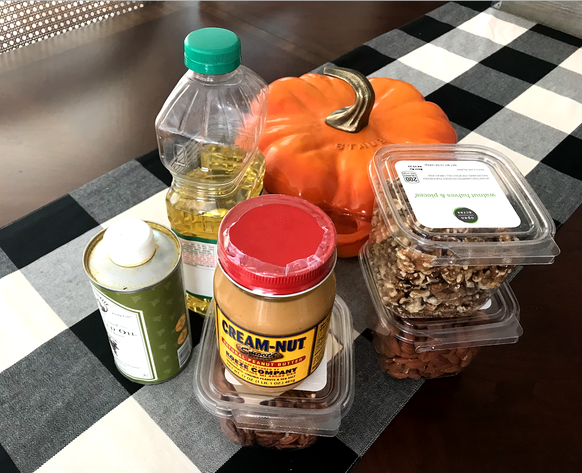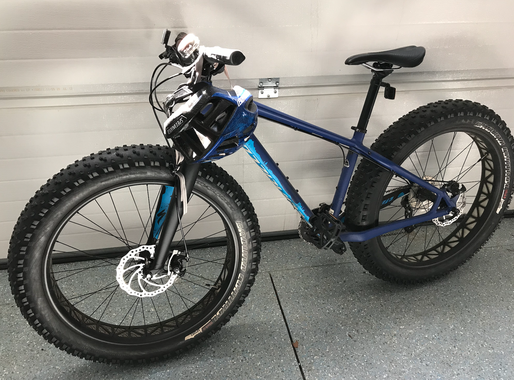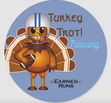BLOG
|
|
WHETHER OR NOT YOU ARE CONCERNED* WITH DIETARY INTAKE of essential and non-essential polyunsaturated fatty acids, (PUFA) you may have encountered the hype surrounding this nutritional issue. The simplified bottom line over the past few decades has been that “Omega-3’s” are good and “6’s” are not.
Thus, consumption of foods and supplements rich in omega-3 fatty acids EPA (eicosapentaenoic acid) and DHA (docosahexaenoic acid) like fatty fish (salmon, mackerel, sardines) and plant seeds (flaxseeds and chia seeds) has been promoted to improve cardiovascular health. Because foods that most commonly show up in our Western diets as the biggest sources of omega-6 fatty acids include snacks and other highly processed convenience/junk foods, rich sources of calories and fats in general, the 6’s have been considered the type of fats to avoid. What’s worse is the reputation difference between 3’s and 6’s in terms of inflammation potential. Omega 3’s have been cast as anti-inflammatory heroes; omega 6’s have been labeled as pro-inflammatory villains. This is an important distinction because long term, low-level, systemic (body-wide rather than localized) inflammation is known to be behind the development of many chronic conditions including cardiovascular disease, diabetes, neuro-degeneration, and cancer. https://www.nature.com/articles/s41591-019-0675-0 As a former dietitian all this information seemed to logically support the simple “3’s are good” and “6’s are bad” labels. That is, until I realized that “healthy” olive oil of Mediterranean Diet fame, is low in Omega-3 and high in monounsaturated and omega-9 fatty acids (another PUFA). And when scientific articles began to appear in my regular email updates from the NIH Library of Medicine that nuts and seeds should be increased in our diets, especially walnuts. Nuts and seeds are high in fat, and many are rich sources of omega-6 fatty acids. What? https://pubs.rsc.org/en/content/articlelanding/2012/FO/C2FO10152A [Before continuing further, a definition is in order. All PUFA molecules have a side chain comprised of multiple carbon atoms. The carbon atoms in the chain are connected to each other, joined by a single or “saturated”, carbon-to-carbon bond or a double, “unsaturated” C-C bond. PUFAs have many (poly) unsaturated bonds; saturated fats have, well, saturated single bonds. The Omega-3 PUFAs have one of their carbon-to carbon double bonds in the three position (third from the end of the chain). The Omega-6 PUFAs have one of their double/unsaturated bonds in the six position (sixth from the end).] https://www.ncbi.nlm.nih.gov/pmc/articles/PMC7037798/ Searching and reading for better understanding on this issue, I learned that the ratio of intake of the different omega’s to each other also effects health. Researchers think that early humans evolved consuming a ratio of about 1:1 (omega-3 to omega-6) fats, and experienced lower levels of lifestyle-related heart disease and diabetes than modern humans. Our Western diets typically provide a whopping 1:16-20 ratio of omega-3 to omega-6!!! https://www.healthline.com/nutrition/optimize-omega-6-omega-3-ratio I knew, in addition, that the story is complicated by the fact that excess adipose tissue in our bodies also generates inflammation. So, by ingesting the many calories contained in “bad 6’s” snack food fats, we tend to make more calorie storage (adipose or fat) cells that increase our risk of living in the harmful state of chronic inflammation for decades. https://www.nature.com/articles/s41591-019-0675-0 My take was that it is best to strive to consume a 1:1 (omega 3: omega 6) ratio by: -decreasing my intake of excessive junk omega-6 fats that would add inflammatory adipose tissue (fat cells) -substituting them with healthier omega-6 rich nuts and seeds, especially walnuts -and adding more omega 3’s in whole foods I thought my mental game approach to the 3’s and 6’s was in place and ready to put into practice. However, recently I happened across a relatively short August 2019 Harvard Health Bulletin article that called into question the pro-inflammatory influence of omega-6 fats. https://www.health.harvard.edu/newsletter_article/no-need-to-avoid-healthy-omega-6-fats The piece indicates that an American Heart Association (AHA) advisory committee, ”two years in the making”, believes that intake of dietary omega-6s benefits cardiovascular health. And that research has debunked the charge that most omega-6 Linolenic Acid (LA) is converted to precursor molecules (arachidonic acid) that promote inflammation. Other newer scientific articles also seem to shift away from making blanket statements labeling omega-6’s as pro-inflammatory but less clearly and boldly. This change in perspective is best explained in the Harvard Health piece, “No Need to Avoid Healthy Mega-6 Fats”, the reason for this blog post. To me it’s almost a 180-degree turnaround from what has been preached by academic nutritionists and seconded by amateur experts. I expect to see more reversals as researchers shift approaches to the study of human nutrition and disease. My personal healthy-fat-intake strategy (outlined above) won’t be drastically changed because of learning of this new viewpoint, but my reading of the literature going forward will be altered. I’ll be looking to learn of other attitude shifts in the scientific community toward dietary fats, including saturated fat, especially in dairy foods. In the future, other foods that were considered harmful may be found to be helpful in promoting health, when taken in context of how much is ingested, especially relative to what else is eaten. *Why does this matter to athletes? Because our dietary choices should be informed rather than misinformed, so that our good exercise habits aren’t negated by poor nutrition habits but rather boosted by them. It’s a shame to avoid foods and snacks that we find help us perform during and recover after athletic efforts if we mistakenly think they are “bad.” Hopefully manufacturers will take note and offer new and improved products. Check out the Harvard article for a nicely written explanation of why the “6’s” don’t need to be avoided but balanced with “3’s” closer to a 1:1 ratio than a 20:1 ratio, and which sources of each are best. RUN & MOVE HAPPY! https://www.webmd.com/diet/features/what-to-know-about-omega-3s-and-fish https://www.mayoclinic.org/diseases-conditions/heart-disease/expert-answers/omega-6/faq-20058172
0 Comments
GETTING OUT EACH MORNING, DAY, OR EVENING TO RUN OR WALK COMES NATURALLY TO THOSE WHO LOVE THESE FORMS OF EXERCISE. However, most of us can benefit from at least one to two days off a week for the purpose of injury prevention. Cross training can be a way to reduce the risk of bodily harm due to overuse. According to an article, "6 Ways Cycling Will Help You Be a Better Runner" by Rick Prince posted by podiumrunner.com, riding, both outside and indoors, not only helps avoid this problem but can actually improve running performance. The piece explains why cycling can improve running (and surely walking too). The paragraph headings relate how this exercise: -Mimics (running) Movement -Strengthens Calf Muscles -Strengthens Shin Muscles -Engages the Core -Builds the Aerobic Engine -Boosts Anerobic Systems If not certain how to properly cycle-cross train to help your running (or walking) performance, the next article (it follows the Prince piece after a number of ads…just keep scrolling down) by Jonathon Beverly provides an indoor cycling workout for this purpose. Beverly’s expert on the topic, Tom Miller PhD, outlines ‘The Standing Hill Interval Training’ session he uses in his coaching and personal life. Miller’s credentials are impressive. The article indicates he’s won the 75-79 year age group in “two of the last three Xterra Trail Running National and World Championships”. Enough said; I’m in. RUN & MOVE HAPPY! https://www.runnersworld.com/health-injuries/a20819497/the-10-laws-of-injury-prevention/ https://www.podiumrunner.com/training/cross-training/why-cycling-is-a-great-cross-training-option-for-runners [THIS UPDATED VERSION WAS INITIALLY POSTED IN 2017. Read it this year if you haven't yet done so. Regardless of intentions to participate in an upcoming November holiday event, both runners and walkers may learn why training on a regulation track may help reach a variety of PHYSICAL ACTIVITY goals in the remainder of this year and the next.]
"IT'S YOUR MOVE! Consider training for a Thanksgiving Day Race in 2021. Unlike 2020 in which the majority of such activities were virtual, there’s a chance that this year most will be held as in-person, real-time events. CHECK OUT the Earned Runs 2021 Turkey Trot Training Plans for runners and walkers (see PDF links below or RESOURCES page). Each is designed to help first-timers prepare to participate in one of the many Thanksgiving Day events that are likely this year to be held across the USA. Not much has changed from the 2020 plans except that they are a week longer. As before, runners have the option of training on a 400-meter track one day a week. The first day of each plan is this upcoming Monday, September 13, 2021. There are a few days before a decision must be made to participate and start training. If it’s a “go”, jump right in and perform the first day’s scheduled workout, letting that experience help you commit to the full 10+ weeks leading to November 25. The running plan was adapted from one developed by Mario Fraioli for Competitor.com (now organized as PodiumRunner.com a part of Outside). The walker plan was adapted from plans offered free online by Hal Higdon. The fact that the Fraioli 5K running plan had a track day scheduled each week was one of the reasons it was selected by Earned Runs for beginners. The TRACK DAY option provides motivation to find a regulation track and take advantage of the potential benefits to be gained from feeling comfortable using one to train. The following is an updated explanation for this choice that was initially posted in 2017. “Why TRACK DAYS?” A TRACK IS A TYPE OF FITNESS EQUIPMENT Many beginning or would-be runners and walkers, may not have ever run, trained, or walked on a standard track. They may not know where the nearest or most accessible high school, college, or community facility is located. It may seem to be a training site that is off bounds to them, and more appropriately used by younger or more ‘serious’ athletes, who are fast, highly competitive, and in top physical shape. In my experience as a recreational walker/runner, there are three characteristics that make a track an essential piece of equipment that all runners and walkers should learn to consider a training ‘home’. A track is MEASURED, SAFE, and ATHLETIC. MEASURED: Specific distance assignments in a plan can be difficult to mentally assess for those accustomed to ‘just running’ or 'just walking' rather than training, especially over shorter rather than longer stretches. A GPS-assisted device can be used to chart a course in miles or kilometers but it requires repeatedly checking that device to be precise with shorter distances. Visually marking exact distances by this method to avoid such device-checking is problematic too, as rarely are there memorable physical features at needed points to help recall the start and end of a set distance. (“Which tree marks 400 meters?”). If a training plan calls for varying distances the measurement difficulties are compounded. A standard track lap or fraction of a lap is a limited distance that looks the same every time you run or walk it. Memorizing a series of landmarks isn’t required to determine the exact distance run or walked. Mentally, a standard track is nearly effortless to use. The track’s straight lengths are easily distinguished from the curved ends, each of which which can be employed for quick successive changes in pace. The time it takes to cover specific distances is relatively easy to measure on a watch or mobile device. I've found that using a track regularly for training helps my body develop a ‘memory’ for different distances. SAFE: Safety is a life quality that has several dimensions: training safety, weather safety, endurance safety, traffic safety.. Training: A running surface can be more or less safe from a training injury prevention perspective, especially when workouts will be performed at higher speeds or in adverse weather conditions. A running track used for competition tends to be even, consistent, textured, slightly cushioned, and appropriately drained. This type of surface, designed for officially certified events, is more likely than others to be safe for running faster-paced, precise intervals. Weather: Your regular road or trail running course may offer various degrees of protection from harsh elements, depending on the potential for exposure to extreme environmental conditions. Or it can leave you far from protective shelter when weather conditions are expected to deteriorate over the duration of a single long workout. On days in which the atmosphere might be hotter, colder, windier, or wetter than is desirable for performance or health, a track session may be the top safety pick. Although running or walking multiple loops of a neighborhood street course has been my preferred approach on such days, a track will do nicely when one is not readily available. On the toughest weather days, a track may beat a street course because supportive gear can be made more accessible. Hydrating fluids, nutrition, and dry, cooling or warming clothes can be stowed in a bag and left in full view at the edge of the track on bleacher seats, only a single lap away, or in a nearby parked car. Endurance: When a runner/walker is uncertain about being able to complete a given workout in its entirety, especially if longer or more difficult than previously experienced, the track can be a great place to safely test individual limits of endurance. You aren't as likely to find yourself miles from the end of tougher than expected finish during a never-before attempted session. Traffic: Personal safety in traffic is another concern of outdoor runners and walkers. Compared to busier urban thoroughfares, a track open only to foot traffic poses minimal to no risk of bodily harm from accidents caused by faster moving vehicles. Especially now that dedicated lanes near the street curb have been marked off for the use of bicycling commuters, rush hour exercise requires environmental awareness of all traffic dangers including those related to poor visibility in lowlight conditions. Some runners and walkers prefer isolated paths or suburban and country roads for avoidance of crowds. However, in cases of emergency these are places where the likelihood of receiving timely assistance from passers-by is diminished. A track can also be unsafe if in an area that is poorly lighted, out of the sight of others, or without security monitoring. Checkout the active.com article by Lauren Hargrave, which provides personal safety tips for runners. ATHLETIC: Performing a workout on a track is one way for beginners to feel and act like the athletes they aspire to become. Acquiring this mental attitude will help a runner or walker persevere in the tougher training regimens and possibly to adopt healthier eating and sleeping habits. The track is also a user-friendly place to perform pre-run dynamic stretching and mobility routines and to get in post-run static stretches as well as body-weight strength exercises (step-ups and step-downs, plank variations, and push-ups, etc) on benches and stairs. Holding to the rule that you cannot start the running/walking portion of the workout or depart from the premises before completing necessary routines increases the chances they will NOT be skipped. In some races the finish line is located on a track and the very last portion of the race includes a partial lap. Performing some workouts on a track can help beginners to visualize a successful goal race finish. Despite the encouragement of Earned Runs, the track may not be a desirable place to train for some. The Track Day Schedule identifies the approximate distances that should be run that day to help you accomplish the session goals without utilizing a track. GOOD LUCK! RUN & MOVE HAPPY! RUNNERS PLAN FREE PDF WALKERS PLAN FREE PDF 2017 TRACK DAY SCHEDULE 2017 Mintues to Miles calculations https://www.halhigdon.com/training-programs/15k-10-mile-training/intermediate-15k-10-mile/ https://www.active.com/running/articles/6-running-safety-tips PREVIEW THE RUNNING AND WALKING training plans for 2021 if you are interested in participating this year. Last November many traditional races were cancelled or held as virtual events. The usual atmosphere of community and celebration was missing though, because we were fearful and mostly prevented from gathering in large groups by local rulings.
Hopefully this autumn will mark the return of in-person organized events. Even though previously many may not have wanted to join in such festivities, perhaps this year participation will be viewed differently. For me the change in viewpoint led to enabling inclusion of neighbors to the north of Michigan in training plans for a Thanksgiving Day event, which in the USA falls in late November. Ever since our (sadly departed) Newfoundland pup’s 1995 travel itinerary to the USA was changed to accommodate the breeder’s wish to celebrate Canadian Thanksgiving Day with her family, I’ve taken note of their national celebration in October each year. In 2021 it falls on Monday the 11th. The earlier date Canadian holiday has a longer history than that of the United States observation, partly because it reflects the different growing season and harvest period. Having visited and dined in Quebec, Ontario, and British Columbia provinces in Canada, there’s no doubt it’s an amazing day of gathering and feasting! [I’m especially eager to again enjoy the cuisine of La Malbaie in the Charlevoix -Est district of Quebec] Unfortunately, this post and the plans are not as early as they should be to allow a full 10-week training period, so abbreviated Canadian Thanksgiving day RUN and WALK plans are posted on the RESOURCES page as of today. Perhaps some to the north will start now and then continue to follow afterward with the Turkey Trot schedules. A separate posting will describe the 5K RUN and WALK Turkey Trot plans in detail, designed to prepare for the USA November date. Because Thanksgiving is a traditional holiday anywhere in the world it is celebrated, the Earned Runs training plans are traditional as well. They have not changed much over the years, nor have the blog posts. But the notion that we are potentially able to return to our “same old” seasonal observances warms my heart. Check out the “same old” Earned Runs Turkey Trot plans and the new shortened Canadian plans and think about making room in the upcoming weeks and months to prepare for joining friends, family, and neighbors in local events. Like the return of pumpkin spice lattes and other similarly seasoned beverages and items on coffee shop menus each year, perhaps the beginning of Turkey Trot training will conjure up cozy autumn scenes and fond remembrances. RUN & MOVE HAPPY! https://www.thecanadianencyclopedia.ca/en/article/thanksgiving-day https://en.wikipedia.org/wiki/Newfoundland_dog https://en.wikipedia.org/wiki/La_Malbaie |
BRIDGE TO PHYSICAL SELF
Running, walking, and fitness activities enable us to experience our physical selves in a world mostly accessed through use of fingers on a mobile device. AuthorEARNED RUNS is edited and authored by me, runner and founder. In 1978 I began participating in 10K road races before 5Ks were common. I've been a dietitian, practiced and taught clinical pathology, and been involved with research that utilized pathology. I am fascinated with understanding the origins of disease as well as health and longevity. Archives
November 2023
CategoriesNew! Search Box
Earned Runs is now searchable! Check it out...
|






 RSS Feed
RSS Feed